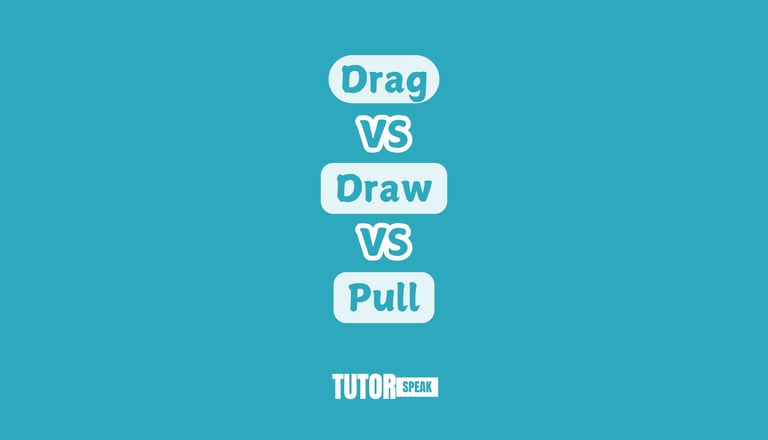Understanding the Difference Between "Drag," "Draw," and "Pull"
The words drag, draw, and pull all involve moving something, but they differ in how the action is performed and the context in which they are used. Let’s break them down with simple explanations, examples, and exercises to help you use them correctly.
TutorSpeak
12/7/20242 min read


Understanding the Difference Between "Drag," "Draw," and "Pull"
The words drag, draw, and pull all involve moving something, but they differ in how the action is performed and the context in which they are used. Let’s break them down with simple explanations, examples, and exercises to help you use them correctly.
1. Drag
Meaning: To move something by pulling it along the ground or another surface, usually with effort.
Key Idea: Implies resistance or heaviness.
Examples:
He dragged the heavy suitcase across the floor.
She dragged the chair to the other side of the room.
Tip: Use "drag" when something is hard to move or is being pulled along a surface.
2. Draw
Meaning: To pull something gently or steadily, or to create a picture.
Key Idea: Implies smooth or controlled movement, or an act of sketching.
Examples:
He drew the curtains to let in more light. (pull gently)
The artist drew a beautiful landscape. (sketch)
She drew water from the well. (pull steadily)
Tip: Use "draw" when describing smooth movements, creating art, or pulling something steadily.
3. Pull
Meaning: To move something toward yourself or in a particular direction by holding and exerting force.
Key Idea: General term for using force to bring something closer.
Examples:
He pulled the door open.
She pulled the rope to lift the bucket.
The dog pulled on its leash.
Tip: Use "pull" for general actions of bringing something closer or moving it toward a direction.
Comparing "Drag," "Draw," and "Pull"
These three words involve the idea of moving something, but they differ in how the action is performed and in their contexts. Here's a simple breakdown:
Drag
"Drag" means to move something heavy or resistant, often scraping along a surface. It usually suggests effort.Example: He had to drag the sofa across the floor because it was too heavy to lift.
Draw
"Draw" refers to a smooth or steady pulling action. It can also mean creating art or pulling something gently.Example (movement): She drew the curtains to let in more light.
Example (art): The artist drew a beautiful portrait.
Example (steady action): They drew water from the well.
Pull
"Pull" is a general term for moving something toward yourself or in a specific direction by exerting force.Example: He pulled the door open with ease.
Summary:
Use drag when something is heavy or difficult to move.
Use draw for smooth movements, steady actions, or artistic creation.
Use pull for general actions of pulling something toward you or in a specific direction.
Exercises
1. Fill in the blanks:
He had to ________ the table across the floor because it was too heavy to lift.
The artist ________ a portrait of his friend.
She ________ the leash to keep her dog from running away.
He ________ the chair closer to the table so he could sit.
They ________ the car out of the mud with great effort.
2. Choose the correct word (drag, draw, or pull):
The student decided to ________ a picture of the school for the art contest.
He used all his strength to ________ the heavy box up the stairs.
She ________ the curtains to block the sunlight in her bedroom.
The child tried to ________ the wagon across the rocky path.
He ________ the rope tightly to make sure it wouldn’t loosen.
3. Matching exercise:
Drag
Draw
Pull
a. To create a picture with a pen or pencil.
b. To move something heavy with effort along the ground.
c. To move something toward you by holding and exerting force.



